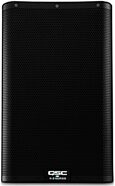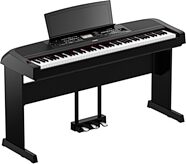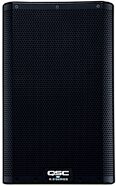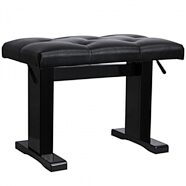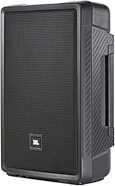Casio PX320 Privia 88-Key Hammer-Action Keyboard
No longer available at zZounds

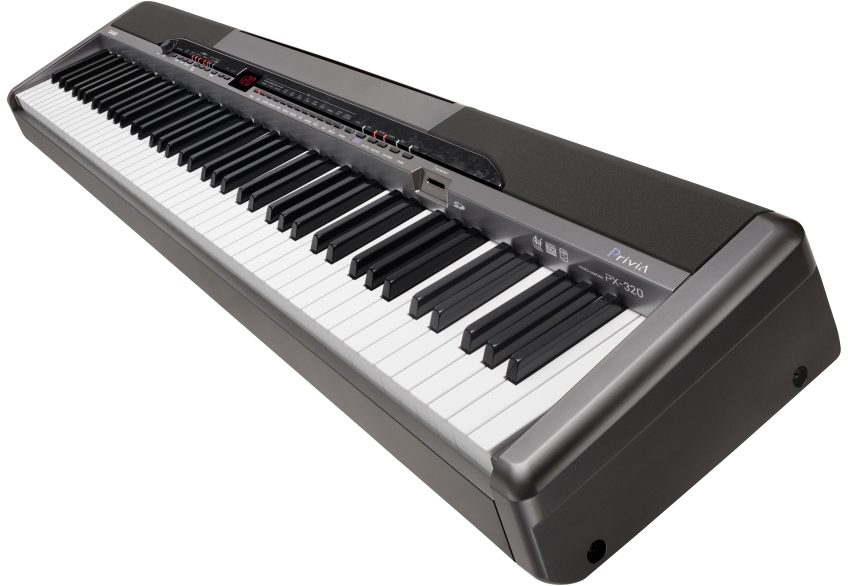
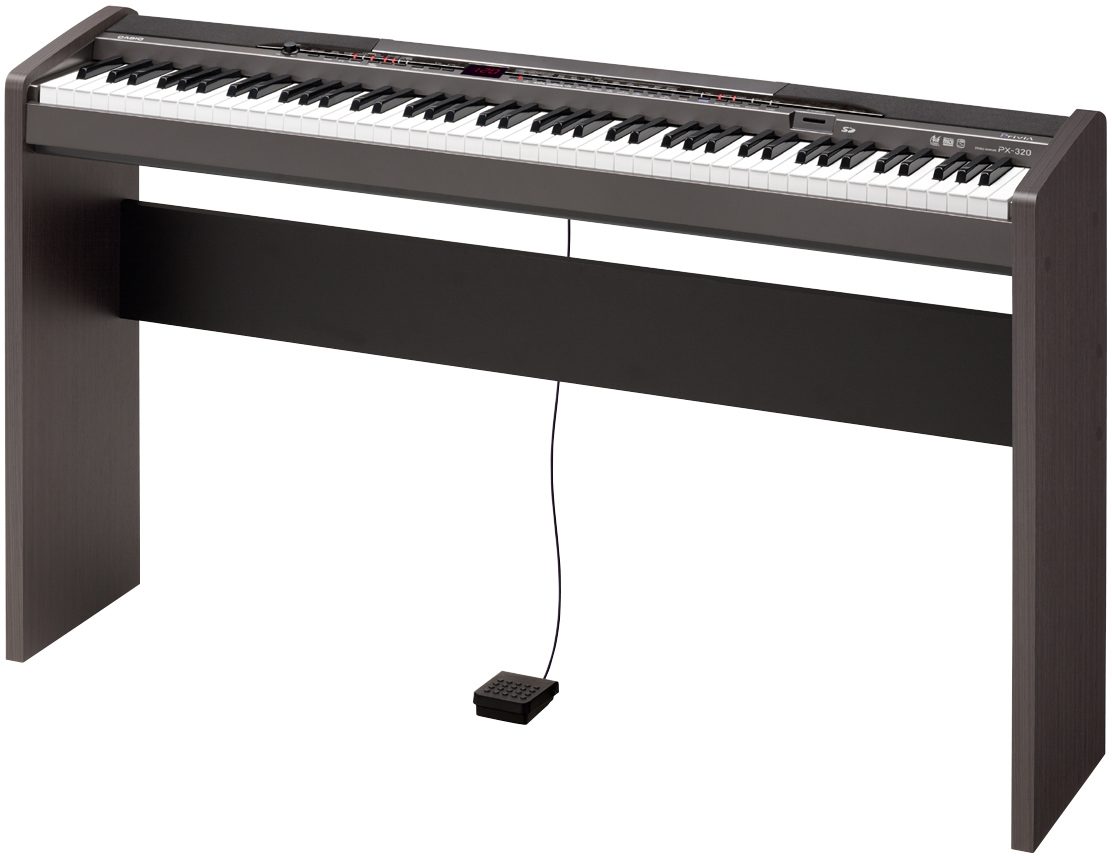
zZounds Gear Experts Say...
88-graded hammer action keys. 2x8 watts speaker system. SD card slot. Stand not included.
Overview
The PX320 is perfect for stage and studio use. Along with the advanced AIF sound source providing 128 notes of polyphony where notes reverberate naturally without being cut off it also has 1/4 inch line outputs for connecting to a mixer or PA system. The 202 tones including organ and drum tones will make you ready for any music style. The 88 weighted and Graded keys provide the look and feel of an acoustic piano.
Features:
88 Weighted and graded keys
Gives the feel of an acoustic piano
AIF Sound Source
The tri-element AIF sound source embodies the very best of Casio waveform technology to take digital piano sound quality as close to that of an acoustic concert grand piano as possible. High-precision stereo sampling of a grand piano combines with a special filter for sounds that reverberate with amazing reality
128 Note Polyphony
The Privia PX-320 is capable of producing up to 128 note simultaneously allowing notes to reverberate naturally without being cut off during high-speed passages and intensive damper pedal operations.
Two Piano Setting Keys
Piano sound tailored to your own taste: The piano setting key switches to grand piano sound at the touch of a button. Two settings are available: "classic" for a soft, discreet sound and "modern" with a more lighter, brighter character.
1/4 in. Stereo LINE IN / OUT
The Stereo LINE IN / OUT (L/mono, R) of your digital piano provides a connection for full sound experiences. e.g. to your PA-system or studio equipment.
High-quality… read more DSP Effects
The PX320 digitally reproduces the high-quality sound of a top concert grand piano complete with first-class reverb effects. The simulation of the resonating strings that is provided by the "Acoustic Resonance" effect rounds the sound experience off perfectly.
Panel-Lock
With the Panel-Lock function, the control panel is protected from unintentional moves while playing and to protect settings.
Powerful Speaker System
The powerful 2-way system with four speakers and 2 x 8 watts of output power ensures a targeted sound delivery.
3 Pedals
With the optional SP30, the PX320 has up to three pedals with half-damper effect. This "half-damper" effect simulates a "half-pedaled" damper pedal.
2 Headphone Connections
Two headphone connections are available read less
Features:
88 Weighted and graded keys
Gives the feel of an acoustic piano
AIF Sound Source
The tri-element AIF sound source embodies the very best of Casio waveform technology to take digital piano sound quality as close to that of an acoustic concert grand piano as possible. High-precision stereo sampling of a grand piano combines with a special filter for sounds that reverberate with amazing reality
128 Note Polyphony
The Privia PX-320 is capable of producing up to 128 note simultaneously allowing notes to reverberate naturally without being cut off during high-speed passages and intensive damper pedal operations.
Two Piano Setting Keys
Piano sound tailored to your own taste: The piano setting key switches to grand piano sound at the touch of a button. Two settings are available: "classic" for a soft, discreet sound and "modern" with a more lighter, brighter character.
1/4 in. Stereo LINE IN / OUT
The Stereo LINE IN / OUT (L/mono, R) of your digital piano provides a connection for full sound experiences. e.g. to your PA-system or studio equipment.
High-quality… read more DSP Effects
The PX320 digitally reproduces the high-quality sound of a top concert grand piano complete with first-class reverb effects. The simulation of the resonating strings that is provided by the "Acoustic Resonance" effect rounds the sound experience off perfectly.
Panel-Lock
With the Panel-Lock function, the control panel is protected from unintentional moves while playing and to protect settings.
Powerful Speaker System
The powerful 2-way system with four speakers and 2 x 8 watts of output power ensures a targeted sound delivery.
3 Pedals
With the optional SP30, the PX320 has up to three pedals with half-damper effect. This "half-damper" effect simulates a "half-pedaled" damper pedal.
2 Headphone Connections
Two headphone connections are available read less
Specs
Keys (full-size): 88
Tones: 202
Rhythms: 70
Digital effects: 8
General MIDI: Yes
Registration: 96 Set Ups (12 sets x 8 banks)
Duet Mode: Yes
Size (WxDxH): 1,322 x 278 x 132mm/1,306 x 288 x 767mm (with optional keyboard stand CS-65P), 52.88 x 11.12 x 5.36 in. (without stand)
Weight: 12kg/21.5kg (with optional keyboard stand CS-65P)
AC adaptor, scorebook and music stand: Yes
Acoustic Resonance System: Yes
Song Expansion: Song expansion, storage for up to 10 songs transferred from a computer, approx 3.1MB maximum user area
Built in high quality speakers: Yes
Touch Response: 3 sensitivity levels, off
Song memory: 2 track x 5 song (up to 50,000 notes)
Bass reflex speaker system: 2-Way
Specifications
Keyboard: Scaled Hammer Action
Keys: 88 (full)
Touch Response: Yes
Tones: 202
Digital effects: 8
Layer / Split: Yes
Song Expansion: Yes
Rhythms: 70
Lesson Function: Yes
Song Controller: Yes
Song Memory / Sequencer (tracks x songs): 2 x 5
Tuning Control: Yes
Polyphony (maximum): 128
Headphones Terminals: 2
Pedals Terminals: 2
MIDI/OUT Terminals: Yes
Line Out Terminals: L/Mono, R
Line In Terminals: L/Mono, R
Registration (set-ups): 96
Auto-Accompaniment: Yes
Speakers (dia x qty): 12cm x 6cm (oval) x 2, 5cm x 2
Key Transpose: Yes
General MIDI: Yes
Bass-reflex speaker system: (2-way)
Tones: 202
Rhythms: 70
Digital effects: 8
General MIDI: Yes
Registration: 96 Set Ups (12 sets x 8 banks)
Duet Mode: Yes
Size (WxDxH): 1,322 x 278 x 132mm/1,306 x 288 x 767mm (with optional keyboard stand CS-65P), 52.88 x 11.12 x 5.36 in. (without stand)
Weight: 12kg/21.5kg (with optional keyboard stand CS-65P)
AC adaptor, scorebook and music stand: Yes
Acoustic Resonance System: Yes
Song Expansion: Song expansion, storage for up to 10 songs transferred from a computer, approx 3.1MB maximum user area
Built in high quality speakers: Yes
Touch Response: 3 sensitivity levels, off
Song memory: 2 track x 5 song (up to 50,000 notes)
Bass reflex speaker system: 2-Way
Specifications
Keyboard: Scaled Hammer Action
Keys: 88 (full)
Touch Response: Yes
Tones: 202
Digital effects: 8
Layer / Split: Yes
Song Expansion: Yes
Rhythms: 70
Lesson Function: Yes
Song Controller: Yes
Song Memory / Sequencer (tracks x songs): 2 x 5
Tuning Control: Yes
Polyphony (maximum): 128
Headphones Terminals: 2
Pedals Terminals: 2
MIDI/OUT Terminals: Yes
Line Out Terminals: L/Mono, R
Line In Terminals: L/Mono, R
Registration (set-ups): 96
Auto-Accompaniment: Yes
Speakers (dia x qty): 12cm x 6cm (oval) x 2, 5cm x 2
Key Transpose: Yes
General MIDI: Yes
Bass-reflex speaker system: (2-way)
Documents and Manuals
For support or warranty questions, please contact the manufacturer:
Phone: 800-435-7732
Web: https://world.casio.com/support/
Phone: 800-435-7732
Web: https://world.casio.com/support/
Reviews
Reviewers gave this product an overall rating of 4.5 out of 5 stars.
(16 ratings)
Submitted June 20, 2008 by a customer from yahoo.com
"BEST BANG-FOR-YOUR-BUCK digital piano in its price range...you won't believe it actually came from a Casio product."
This review has been selected by our experts as particularly helpful.
I'd probably supplement it with a good sound module to add better strings, some brass instruments (particularly saxophone patches)
Sound
There are 2 "main" grand piano patches in the PX-320: The "MODERN GRAND PIANO" (which has a slightly brighter sound, "non-muddy" full bass sound on the lower register and "sparkly" sound on the higher registers) and a "CLASSIC GRAND PIANO" (which has a softer, more gentle and tempered sound but still has a rich, deep bass sound on lower registers and "delicate" sound on the higher registers). Personally, I use the MODERN GRAND PIANO patch for pop, dance and rock music during gigs since it has more "kick" into it. The CLASSIC GRAND patch I use for playing classical music when I'm at home and for certain ballads/love songs that our band may play during gigs that don't require a powerful or bright sound but a "mellow"/"soft" one. You can fully appreciate the excellent decay and resonance of each note played when using headphones or when connected to loud speakers. There are many other variation piano sounds in the PX-320 (some located in the Various Tone section and some in the GM section). To mention a few, it has L.A. piano, Mellow piano) There are decent EP sounds (60's EP, Dyno-EP and 2 others I can't recall at the moment) and some decent, if not good, useable organ patches as well. The brass ensemble patches are fine (the saxophone patch could use more samples and improvement but they can still… read more be fairly useable on certain songs).
Features
The most useful feature in the Privia PX-320 is the registration memory. Given only a simple 3-digit LCD display, patch numbers for individual tones may be difficult to memorize. However, with the registration memory, you can store any favorite instrument tone (layered, or non-layered) as well as many other keyboard settings (keyboard split-point, brightness settings for the piano, reverb/chorus effects, rhythm accompaniment style, tempo settings etc.) The next useful feature is the LINE-OUT ports (L & R) which is handy for connecting the PX-320 to loudspeakers (e.g. PA system, monitor speakers, keyboard amps, or even a simple Stereo Hi-Fi Component system with AUX-IN). This is important for gig musicians who regularly hook up their gears to loudspeakers during performances. Another useful feature is the 2-track recorder feature which is good for recording music ideas/arrangements or simple keyboard/piano performances when you feel like recording on-the-spot MINUS the need for the PC and recording softwares. And I certainly appreciate the 16-channel multitimbral General MIDI compatibility of the PX-320. Sending and receiving MIDI is I wish the PX-320 had a pitch-bend wheel (useful for guitar patches). A larger LCD display (colored or monochrome) would be very much appreciated although during live stage performances or gigs in clubs where lights in the stage are "dim", the red 3-digit LCD display is more than sufficient to be seen by the keyboardist clearly...based on my experience. I wish there was a brass slide patch, however, which is often used by real brass players to add "style" to their playing. But the lack of brass slide is only a minor matter, as you could always have this by connecting the PX-320 to a good sound module and/or VSTi-equipped laptop which you can easily bring along with you during gigs. I also wish the PX-320 had a "bass guitar slide" patch that can be handy when making home recordings, arrangements or even during live performances (on a keyboard-split mode) when you lack a bass guitarist who can do those "slides" and add flavor to the song your playing/arranging.
Ease of Use
The interface is simple. There are several dedicated function buttons and instrument tone buttons on the control panel. To access other tones (there are 202 built-in instrument tones), you need to press the "Various Tones/GM tones" button while pressing the "YES/NO" button to scroll up or down the instrument patch list. This may be a bit disconcerting at first, since you see only the instrument number and not the instrument name (you may have to memorize the patch number of your favorite instrument tones). Changing/shifting from one instrument tone to the another is handled EASILY with the use of the registration memory. Recalling your favorite instrument patches also is made easy using the registration memory features (there are 96 registration memory banks which you could use to store various keyboard settings I've mentioned above/earlier.
Quality
I've only had the PX-320 for 4 months but I've been using it in gigs with my band 3 days after it arrived (I still had to familiarize myself with features and function buttons prior to using it in gigs for a "trouble-free" use during live performance of course)... It has been reliable and rock-steady so far. and I haven't experienced any problem with it yet. It seemed to be holding out quite well so far considering I've been moving it around and using it in gigs. The keybed seem to be handling several hours of practice everyday...so far no problems in this regard. I've probably be extra careful when carrying it around so as to avoid bumping the side panels of the PX-320 since these are made of plastic and can be dented or broken if hit hard on corners or walls.
Value
It's worth the $700-$800 price its currently being sold at in different stores (depending on whether it is packaged with/without C65 wooden stand and pedals). This is simply one of the best digital pianos with good "price-to-features" ratio.
Manufacturer Support
I've e-mailed Casio customer support when I was inquiring about the PX-320 twice and response came in within 24 hours from the time I sent the e-mails. I've e-mailed them again recently giving them some "feedback" on how they could improve the functionality of their digital pianos and they have been more than receptive and even encouraged me to send them suggestions as to features or how they could improve their products in the future. Response came in within 24 hours again. (In that e-mail, I also gave a negative feedback of Casio's older PX-575R/PX-410R digital piano which lacked good polyphony and dedicated LINE-OUT ports which didn't make it "gig-friendly" or multi-track instrument-friendly. THANKFULLY, the PX-320 has 128-note polyphony and dedicated LINE-OUT ports!) I'm yet to experience problem with the PX-320, and so I couldn't fully assess their after-sales customer support...for this, I'm holding out on giving them a perfect score.
The Wow Factor
The PX-320 is not bulky...which is actually good for gig-musicians having to carry it out on gigs. The external design is rather "minimalistic" and simple. The 3-digit LCD display may be disconcerting for others...but when I'm carrying it around, at least, I wouldn't have to worry about bumping and breaking a larger, touch-screen LCD displays that more expensive digital pianos have.
Musical Background:
I'm an active musician playing regular on gigs during weekends with my band (or sometimes on a solo gig in certain events when o
Musical Style:
Pop and fusions (pop-rock, pop-jazz), contemporary jazz, rock, some alternative music selections that make use of keyboard sound read less
Sound
There are 2 "main" grand piano patches in the PX-320: The "MODERN GRAND PIANO" (which has a slightly brighter sound, "non-muddy" full bass sound on the lower register and "sparkly" sound on the higher registers) and a "CLASSIC GRAND PIANO" (which has a softer, more gentle and tempered sound but still has a rich, deep bass sound on lower registers and "delicate" sound on the higher registers). Personally, I use the MODERN GRAND PIANO patch for pop, dance and rock music during gigs since it has more "kick" into it. The CLASSIC GRAND patch I use for playing classical music when I'm at home and for certain ballads/love songs that our band may play during gigs that don't require a powerful or bright sound but a "mellow"/"soft" one. You can fully appreciate the excellent decay and resonance of each note played when using headphones or when connected to loud speakers. There are many other variation piano sounds in the PX-320 (some located in the Various Tone section and some in the GM section). To mention a few, it has L.A. piano, Mellow piano) There are decent EP sounds (60's EP, Dyno-EP and 2 others I can't recall at the moment) and some decent, if not good, useable organ patches as well. The brass ensemble patches are fine (the saxophone patch could use more samples and improvement but they can still… read more be fairly useable on certain songs).
Features
The most useful feature in the Privia PX-320 is the registration memory. Given only a simple 3-digit LCD display, patch numbers for individual tones may be difficult to memorize. However, with the registration memory, you can store any favorite instrument tone (layered, or non-layered) as well as many other keyboard settings (keyboard split-point, brightness settings for the piano, reverb/chorus effects, rhythm accompaniment style, tempo settings etc.) The next useful feature is the LINE-OUT ports (L & R) which is handy for connecting the PX-320 to loudspeakers (e.g. PA system, monitor speakers, keyboard amps, or even a simple Stereo Hi-Fi Component system with AUX-IN). This is important for gig musicians who regularly hook up their gears to loudspeakers during performances. Another useful feature is the 2-track recorder feature which is good for recording music ideas/arrangements or simple keyboard/piano performances when you feel like recording on-the-spot MINUS the need for the PC and recording softwares. And I certainly appreciate the 16-channel multitimbral General MIDI compatibility of the PX-320. Sending and receiving MIDI is I wish the PX-320 had a pitch-bend wheel (useful for guitar patches). A larger LCD display (colored or monochrome) would be very much appreciated although during live stage performances or gigs in clubs where lights in the stage are "dim", the red 3-digit LCD display is more than sufficient to be seen by the keyboardist clearly...based on my experience. I wish there was a brass slide patch, however, which is often used by real brass players to add "style" to their playing. But the lack of brass slide is only a minor matter, as you could always have this by connecting the PX-320 to a good sound module and/or VSTi-equipped laptop which you can easily bring along with you during gigs. I also wish the PX-320 had a "bass guitar slide" patch that can be handy when making home recordings, arrangements or even during live performances (on a keyboard-split mode) when you lack a bass guitarist who can do those "slides" and add flavor to the song your playing/arranging.
Ease of Use
The interface is simple. There are several dedicated function buttons and instrument tone buttons on the control panel. To access other tones (there are 202 built-in instrument tones), you need to press the "Various Tones/GM tones" button while pressing the "YES/NO" button to scroll up or down the instrument patch list. This may be a bit disconcerting at first, since you see only the instrument number and not the instrument name (you may have to memorize the patch number of your favorite instrument tones). Changing/shifting from one instrument tone to the another is handled EASILY with the use of the registration memory. Recalling your favorite instrument patches also is made easy using the registration memory features (there are 96 registration memory banks which you could use to store various keyboard settings I've mentioned above/earlier.
Quality
I've only had the PX-320 for 4 months but I've been using it in gigs with my band 3 days after it arrived (I still had to familiarize myself with features and function buttons prior to using it in gigs for a "trouble-free" use during live performance of course)... It has been reliable and rock-steady so far. and I haven't experienced any problem with it yet. It seemed to be holding out quite well so far considering I've been moving it around and using it in gigs. The keybed seem to be handling several hours of practice everyday...so far no problems in this regard. I've probably be extra careful when carrying it around so as to avoid bumping the side panels of the PX-320 since these are made of plastic and can be dented or broken if hit hard on corners or walls.
Value
It's worth the $700-$800 price its currently being sold at in different stores (depending on whether it is packaged with/without C65 wooden stand and pedals). This is simply one of the best digital pianos with good "price-to-features" ratio.
Manufacturer Support
I've e-mailed Casio customer support when I was inquiring about the PX-320 twice and response came in within 24 hours from the time I sent the e-mails. I've e-mailed them again recently giving them some "feedback" on how they could improve the functionality of their digital pianos and they have been more than receptive and even encouraged me to send them suggestions as to features or how they could improve their products in the future. Response came in within 24 hours again. (In that e-mail, I also gave a negative feedback of Casio's older PX-575R/PX-410R digital piano which lacked good polyphony and dedicated LINE-OUT ports which didn't make it "gig-friendly" or multi-track instrument-friendly. THANKFULLY, the PX-320 has 128-note polyphony and dedicated LINE-OUT ports!) I'm yet to experience problem with the PX-320, and so I couldn't fully assess their after-sales customer support...for this, I'm holding out on giving them a perfect score.
The Wow Factor
The PX-320 is not bulky...which is actually good for gig-musicians having to carry it out on gigs. The external design is rather "minimalistic" and simple. The 3-digit LCD display may be disconcerting for others...but when I'm carrying it around, at least, I wouldn't have to worry about bumping and breaking a larger, touch-screen LCD displays that more expensive digital pianos have.
Musical Background:
I'm an active musician playing regular on gigs during weekends with my band (or sometimes on a solo gig in certain events when o
Musical Style:
Pop and fusions (pop-rock, pop-jazz), contemporary jazz, rock, some alternative music selections that make use of keyboard sound read less
83 of 87 people (95%) people found this review helpful. Did you?
Thanks for your opinion!
No longer available at zZounds
In most cases, a product is unavailable because it has been discontinued by the manufacturer
This is a carousel with product cards. Use the previous and next buttons to navigate.




